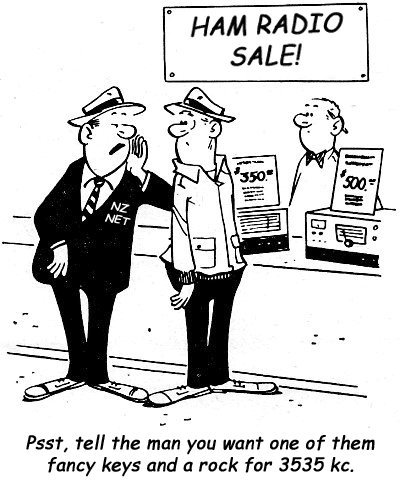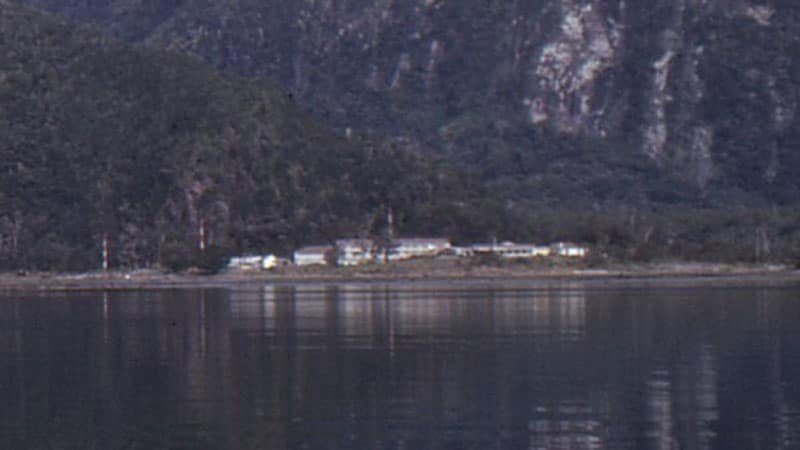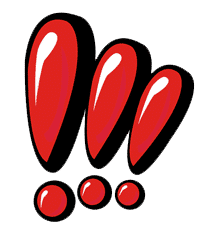This is a fortnightly newsletter about the New Zealand Net.
If you would like to be notified by email message when a new edition is published, please contact ZL1NZ.
You are also welcome to browse our newsletter archive.
Featured key
Have you ever seen a key like this? It’s a CW Combine, in which the operator uses their thumb, finger tip and knuckle. The best way to understand how it works it to watch the video.
The operator is Valery Pakhomov UA3AO, who says the key was made in the USSR before World War Two for “Special Radio Services,” although I’m not sure what that refers to. I’m also not clear on why it appears to have a Vibroplex nameplate.
In this video, Valery is providing a demonstration for David N1EA, hence the “Dear David” at the start.
Characters that include strings of dahs sound really smooth, thanks to the very fluid side-to-side motion between the two levers.
Valery has more videos showing various ways you can use the CW Combine.
Quick notes

Grant ZL2GD, our Mon/Tue Net Control, is back from a week of holidaying in New Plymouth. Next time I hope he can make it farther north for a visit to Auckland.
Traffic for Masterton? We’re ready for it, thanks to having Stephen ZL1ANY and Steve ZL2KE joining the traffic-handling ranks recently. Many evenings we have more stations on the net from Masterton (pop. 26,800) than we do from Auckland!
Maori Language Week was marked on NZ Net, with a trivia question addressed to “Aotearoa Net” which asked for Maori translations of the words “radio”, “telegraph” and “technology.” There was an excellent response to this question and some of the replies contained additional words or phrases in Te Reo Maori. Ka pai!
The 400th Session of the NZ Net will be in a fortnight, on Friday 2 October. Let’s celebrate by filling the ether with CW on 3535!
Several people have said recently how much they enjoy reading NZ Net News. Don’t forget you can write articles too! You might be interested to know that this little newsletter is read by almost 200 people in half a dozen countries. (Wouldn’t it be great to have them all check into the Net!)
If you’d like to do a presentation about NZ Net for your radio club, I am happy to help you with materials. We have a brochure you can hand out and lots of printed and audio resources. As well, I can join your presentation via Zoom (or CW!) if that would be helpful.
Photo flashback
A recent NZ Net Trivia message asked which two stations were involved in handling radiograms to and from Milford Sound in the 1940s.
One of them, obviously, was Milford Sound Radio ZMV, and the station’s principal link to the “outside world” was Awarua Radio ZLB, 200km to the south.
Here is a photo of the Milford Sound settlement taken in 1980, with the masts of ZMV visible.

A challenging radio location! Photo: Peter Munro
Here’s more information about Milford Sound Radio ZMV. Be sure to follow the links for some great first-hand accounts of working there.
Exclamation points!
In the previous newsletter, I wrote about modern, unofficial ways to send an exclamation point, since the official signal for an exclamation point (dah-dah-di-di-dah-dah) was redefined, as a comma, in 1939, leaving us without a bona fide “!”.
I got a couple of replies from NZ Net members who are former ship radio officers, both of whom recall using the old exclamation point much later than 1939.

I’m sure we always used it as dah-dah-di-di-dah-dah. I can also recall when working on the ships and someone was using 500 kHz inappropriately, especially during the Silence Period, someone else would be sending ! dah-dah-di-di-dah-dah, asking them to shut up or QSY!
– Manny VK3DRQ
I had it in my head that dah-dah-di-di-dah-dah was an exclamation mark. The reason being, when we wanted to draw attention to some other operator being an idiot, we would send dah-dah-di-di-dah-dah. You can put a lot of expression into that by elongating the dashes!
– David ZL2WT
As you can seek, traditions don’t change quickly.
And, congratulations if you noticed that I slipped in some new-style exclamation points (dah-di-dah-di-dah-dah) during the first session of the Net after the last newsletter.
Whose aerial is that?
 To which net member does this enviable aerial belong?
To which net member does this enviable aerial belong?
Here’s what the owner has to say about it:
My 80m dipole is pulled through the tree tops with nylon rope and the ends tied off well above the valley floor. Best guess is around 17 metres above ground at the centre. The aerial is slightly off-centre fed, which raises the impedance to around 110 ohms. I feed it with a quarter wave of RG6 (75 ohm) coax, then back to the shack with RG8 (50 ohm) coax.
The off-centre feed is due to the location of the trees, but it has a useful unintended outcome: increased bandwidth. This is a property of quarter-wave stubs interacting with the antenna reactance as you move away from resonance. There are small losses at band edges, but this has no practical impact.
Whose aerial is this?
Morse musings
The “Morseman” Gary Bold ZL1AN (SK) had a theory about code speed. He reckoned that slow ops often over-estimated their speed, while fast ops tended to under-estimate their speed.
(I don’t recall what defines slow versus fast.)
Have you noticed anything like this with our own sending?
Some modern rigs with built-in keyers will tell you your speed. With my stand-alone keyer, I just turn the knob until it sounds “about 20wpm” for the NZ Net (or perhaps it’s a little “under” or “over”). 🙂
Signs of the times
Did you see the news a few days ago that the radio regulatory agency in Brazil is proposing that the basic level of amateur radio licence no longer require an examination? For the record, the group that represents Brazil’s amateur operators is not impressed, and says it wasn’t consulted about the proposal.
The above item is true, but the following item – thankfully – is not.
New class of amateur licence
 Canadian amateur radio operators will be excited to hear that a new class of license will be available soon: the Quiet Radio Transmitter or QRT license. To qualify for this license you need to simply agree to never transmit.
Canadian amateur radio operators will be excited to hear that a new class of license will be available soon: the Quiet Radio Transmitter or QRT license. To qualify for this license you need to simply agree to never transmit.
A 2019 study found that 73% of hams never transmit. Most interestingly, the study found a third of those not only don’t want to transmit, but object to others transmitting, preferring to have silence for hours, if not days on end.
As one survey respondent said, “We invested over $1000 in equipment to set up our club’s repeater and yet people think they can just use it as if this were a hobby. It is really bothersome to hear someone looking for a QSO. It only encourages others to join in and, before you know it, everyone’s on the air disturbing the peace and quiet.”
Commercial interests across the country are welcoming the arrival of the QRT license. Speaking at a spectrum auction, an industry representative said, “This really speeds up the process of taking back our VHF and UHF spectrum from the Ham community. As people see the benefits of a QRT license such as no antennas, longer battery life, and no RFI, they will quickly see that it makes sense to hand over the spectrum to us so more kids can send emoticons to each other instead of wasting their time experimenting with electronics.”
Scrambled signals

What is that weird thing in the photograph, and what does it mean?
The first correct answer wins a virtual chocolate fish.
Email your reply or, even better, send a radiogram to ZL1NZ via NZ Net!
In the previous newsletter, I asked if anyone could give me the meaning of the following prosign, which I represented in this unconventional manner.
<PN>
If you sound it out, you’ll think of other ways it could be represented, such as
<WR>
or
<AC>
The latter version appears to be the preferred representation, and some people refer to it as “at commercial”.
What does it mean? It’s the @ symbol, used in email addresses, which I suppose looks like an “a” inside a “c”.
Net tip: Using full break-in on the Net
This week a net member asked me whether he should use full break-in to interrupt a station sending him traffic on the Net.
Full break-in is a subject dear to my heart, so get ready for a long-read!
What is full break-in?
With full break-in (often called QSK) your receiver is fully operational in between your transmissions. In practice, it should allow you to hear between words, and most modern rigs with break-in will let you hear between characters. The ultimate would be to hear between the elements (dits and dahs) of a character, although I’m not convinced that you gain a lot by being able to hear during a gap the length of a dit!
Many years ago, I ran full break-in on a daily traffic net. But that was using a separate transmitter and receiver. When transceivers came along in the 1960s, they offered something optimistically called “semi break-in.” That simply meant that you didn’t have to throw switches when changing from receive to transmit and vice versa. As soon as you touched your key, the rig switched to transmit, but there was a delay switching back to receive when you stopped sending. The delay was controlled by the VOX circuit.
Then came rigs such as the solid-state Tentec transceivers with glorious full break-in. And nowadays lots of transceivers have it, although few linear amplifiers are designed for that super-fast switching.
If your rig offers full break-in, and you’re not using it, I would urge you to give it a go. It might take getting used to, but in my view it makes CW operation more efficient and more enjoyable (and fone ops have nothing to match it unless they’re running duplex).
If you ever get a chance to hear a couple of skilled ops exchanging traffic using full break-in, I think you’ll be very impressed. Let’s say the receiving op misses a word. They just touch their key. The sending op stops, goes back to the start of the last word they sent, and starts sending again. No need for a “WA” or the usual fill requests. It’s magic.
Ideally, everyone on the net would run full break-in. This would also make it almost impossible for stations to double.
But some of us don’t have it, so we have to make do with fairly short delays on our “semi break-in.”
How to use full break-in for traffic handling.
Here’s how I believe it ought to be done, so let me hear from you if you have a different view!
The sending operator decides whether to allow the receiving station to “break in” (interrupt) while the message is being sent. They do this by preceding the message with QSK, meaning “I can hear between my signals and you are welcome to break in.”
So after hearing QRV from the receiving station, the sending station would send:
QSK <CT> NR9 R ...
Of course, you don’t need to have full break-in on your rig in order to interrupt a station with full break-in. It is only necessary that the sending station be able to hear between their signals.
When not to break in on a station sending traffic
If conditions are marginal, the sender may not hear you trying to break-in, so things could get really messy as you end up missing more words while you’re trying to break in.
If the message is being sent to more than one station (e.g. a QNC) then I think it’s best not to interrupt. Other stations may be copying fine, and you can ask for your fill(s) at the end.
In summary
- I recommend that you only break-in if the sending station precedes their message with QSK.
- If you are sending traffic to another station on the net, and you have full break-in, then by all means let them know they can break-in, by sending QSK before the message.
Fun fact
What is the opposite of the QSK signal? It’s ZBL, meaning “I cannot hear you between my signals. Do not attempt to break in.” But there are probably very few ops who know the Z signals! That’s why I think it’s best to assume you should not break in unless the sender tells you it’s OK.
Suggestions?
If you have suggestions on how to make the NZ Net better, or things you’d like to see covered in these updates, please contact ZL1NZ. You might even like to write something for the newsletter.
Thanks for reading, and I hope to see you soon on the NZ Net!
—
Neil Sanderson ZL1NZ, Net Manager
New Zealand Net (NZ NET)
3535.0 kHz at 9pm NZT Mon-Fri



